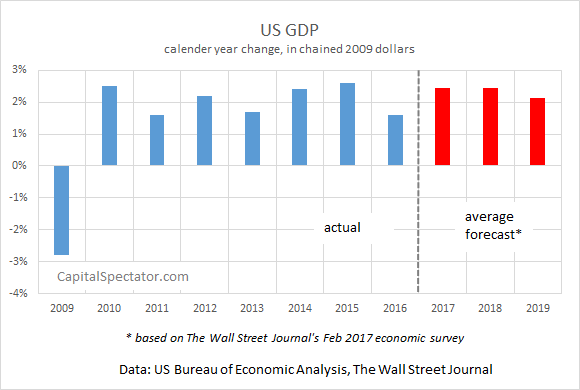Trumponomics Vs. Economic Forecasts
Economic forecasting that’s largely informed by politics is a treacherous affair, but it may be unavoidable in the current climate. If you’re a Donald Trump supporter there’s a good chance that you’re anticipating stronger US growth. But if you voted for someone else last November, it wouldn’t be surprising to learn that you’re skeptical that a dramatic acceleration in the economic trend is near.
This much is clear: if you’re taking clues from the White House, the future looks bright. The Wall Street Journal last week reported that the Trump administration has directed the Council of Economic Advisers to project GDP growth will be a sustainable 3.0 to 3.5% going forward. What’s the foundation for this rosy outlook? The answer starts with Trump’s plans to cut taxes, pare regulations, renegotiate trade deals, and roll out a huge infrastructure-spending program.
If the administration’s upbeat estimates are correct, the future will certainly compare favorably with recent history. GDP increased by a weak 1.6% last year, according to the Bureau of Economic Analysis, down from the mid-2% range in each of the two previous calendar years. A 3.0%-to-3.5% advance, by comparison, would be the economic equivalent of manna from heaven.
But now comes the tricky business of deciding if the optimism for such a hefty improvement in growth is warranted. The trouble starts with the usual challenges, namely, predicting economic activity beyond a few months is more guesswork than science. Even if you’re fully on board with the administration’s estimates, implementing the policies that will deliver the goods will take time and be subject to the standard tweaks in Congress.
Putting those caveats aside, let’s throw caution to the wind and consider what forecasters are expecting for next year and 2019, based on this month’s survey data via The Wall Street Journal. The good news on this front is that dismal scientists see faster growth in 2018, albeit well short of the 3.0%-to-3.5% pace that White House is shooting for. The average estimate for 2018 sees an increase of 2.5% in real GDP, a bit faster than the expected 2.4% rise for this year and moderately faster than 2016’s weak 1.9% rise. But the trend is set to weaken in 2019 to 2.1%.

Keep in mind that there’s quite a bit of variability in the economic forecasts. For example, two economists out of the 62 surveyed expect that growth will reach 3.5% next year and one unusually optimistic forecaster thinks the economy will surge 4.5% in 2018. At the opposite end of the spectrum, one dismal scientist lives up to the label and warns that US economic activity will slow to a crawl next year, sliding to just 0.5%.
The average forecasts for 2018 and 2019, however, anticipate a rate of growth that’s more or less in line with recent history. Economists think that last year’s weak pace will perk up, but the rebound will bring us back to the relatively modest trend that’s prevailed since the Great Recession ended in mid-2009.
Should you expect something better? Maybe. But if you’re looking for a stronger-than-expected increase in growth based on a political calculus, don’t forget that this knife can cut two ways. The New York Times reports today that “Weakened Democrats Bow to Voters, Opting for Total War on Trump.” Not exactly the ideal backdrop for enacting pro-growth legislation quickly and efficiently.
Although everyone supports faster growth, the political path to reaching the Promised Land could be rocky. Fortune points out that several roadblocks in Congress could be lurking for turning Trump’s economic agenda into reality. Meanwhile, there’s a possibility that the President’s boisterous commentary on international trade could come back to haunt the US economy if the tough talk leads to a trade war. There’s also concern that Trump’s immigration policy could weigh on growth.
Nonetheless, it’s possible that economists are underestimating the potential for an upside regime-shift in the macro trend. If so, what’s keeping the estimates so low? Political bias could be a factor. Or maybe the less-than-stellar forecasts really are a sober reading of the big-picture prospects, based on the numbers in hand.
Whatever the future brings, the political factor is sure to play a role, for good or ill. As Investor’s Business Daily points out, “President Trump sailed into office in January on a raft of promises about reviving the slow-moving American economy…. Whether he can achieve this ambitious agenda will depend on his working relationship with Congress — and on his credibility and goodwill among American voters.”
Disclosure: None.



